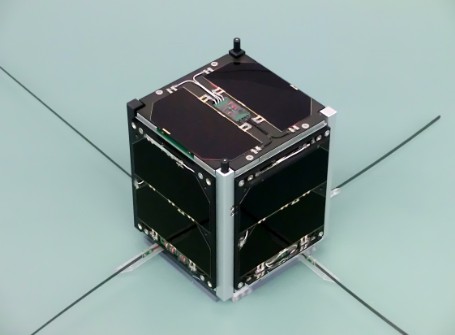How to receive Funcube satellite telemetry
How to receive satellite telemetry from FUNcube (AO-73)

Funcube -1 ( AO-73 ) is a small cube shaped satellite launched into Earth's orbit on Nov 21'st in 2013.
Funcube.org states;
"FUNcube-1 (AO73) is a complete educational 1U CubeSat with the goal of enthusing and educating young people about radio, space, physics and electronics."
The satellite carries a material science project and amongst other things has the capacity to transmit telemetry that anyone with suitable equipment can receive.
By suitable equipment they are not describing a 20 metre dish and huge rack of electronics. Receiving the telemetry from this small satellite involves a dongle, antenna, a laptop and lots of patience.
FUNcube-1 flight model – Image credit Wouter Weggelaar PA3WEG
Before continuing I should make it clear that I knew nothing about this subject until December 2015 and over the past eight weeks have spent a great deal of time and effort trying to understand the subject. As time goes on I will update these pages with what I have learnt.
I would urge anyone thinking about this to visit the AMSAT-UK and Funcube websites for further information. In truth these are the main sources of information I have found regarding this particular satellite. Furthermore, there are many alternate methods to receiving this data however this is the way I have done it.

The laptop on the left of the image can be seen running the "Dashboard" software used to decode the telemetry you will hopefully be receiving as the satellite passes overhead.
Here is a link to the software download and installation instructions. I would urge you to read the install notes prior to using the software and the current version is listed as FUNcube Dashboard Installer v848
There is an option for you to upload your received telemetry to a data warehouse which will require you to register first. This helps the project compile data from stations much like mine located around the world.
Here is the link http://warehouse.funcube.org.uk/

This is the FUNcube dongle, designed by a guy called Howard Long. This is the second iteration of the device and can be purchased from here http://www.funcubedongle.com/
The dongle is a software-defined radio ( SDR ) replacing much of the hardware used in a traditional radio receiver with software. As such there are no physical controls on the dongle other than the USB and antenna connexions.
Remember the satellite contains a telemetry beacon operating at around 145Mhz, this dongle can be used to receive and decode the transmissions.

Of course you will require a suitable antenna for receiving the data transmission as the satellite passes overhead and this proved to be very troublesome for me.
The photo shows my current antenna which I ended up purchasing from here http://shop.amsat.org.uk/
Despite my best endeavours and endless trips to hardware suppliers for copper tubing etc, I was unable to build a suitable antenna. This was compounded by the fact I did not know what good telemetry looked like as I had not received any !
My advice is to purchase the antenna, spend some time developing a good baseline and then continue experimenting with home built antennas if you so desire.
The antenna is extremely simple to assemble and mount on a suitable base. Positioning of the antenna is very important as I found out after many days of very weak telemetry reception.
I should finally add to this part a note about cabling. The antenna is supplied with a 2 metre length of coaxial cable for connection to the FUNcube dongle. This was several metres too short for my set up and I ended up purchasing several different cables and connectors from Amazon to extend the cable length.
I used 10 metres of AKORD 50 Ohm RG58 BNC Coaxial cable, a pack of 3 SMA Female to BNC Female RF Coax adapters from Superbat and an SMA Male to BNC Female plug adapter Pigtail cable.
Total cost was round 20.00 UKP
Click here to go to the second part describing how to receive the telemetry and what you can expect to observe
